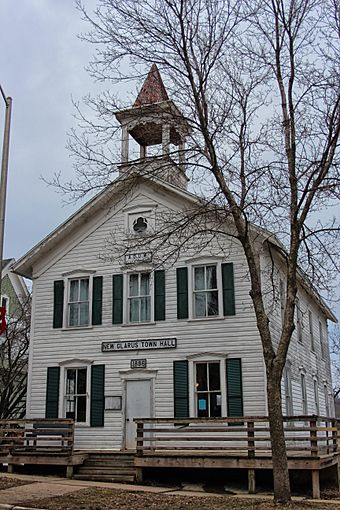New Glarus Town Hall facts for kids
Quick facts for kids |
|
|
New Glarus Town Hall
|
|
 |
|
| Location | 206 2nd St. New Glarus, Wisconsin |
|---|---|
| Built | 1886 |
| NRHP reference No. | 08000286 |
| Added to NRHP | April 11, 2008 |
The New Glarus Town Hall is a special building in New Glarus, Wisconsin. It was built in 1886. This building served two main purposes: it was the town hall, and it was also a meeting place for a group called the Ancient Order of United Workmen. This historic building was added to the National Register of Historic Places in 2008, which means it's recognized as an important part of history.
Contents
Building History
Early Settlers and Growth
The first people to settle in New Glarus arrived in 1845. They were immigrants from Glarus, Switzerland. By the 1880s, the community had grown quite a lot. More than 1,000 people lived there. Many of them worked in farming, making cheese, and other jobs that supported the town.
Building Together
In 1886, the town leaders and the Ancient Order of United Workmen (AOUW) decided to build a shared building. The AOUW was a group that offered support and insurance to its members. The town bought the land for the building. They also paid for the basement and the first floor. The AOUW then paid for and built the second floor. This way, both groups had a place to meet and work.
Building Style and Look
The New Glarus Town Hall still looks very much like it did when it was first built. It sits on a strong foundation made of limestone blocks. It has two stories and is made of wood. The building has a balanced look with windows and doors placed evenly. It features small decorative columns called pilasters at the corners. There are also special boards and trim under the roof, which are common in the Greek Revival style.
At the very top, near the roof's peak, there is a small, unique window. It is shaped like a Gothic trefoil, which looks like a three-leaf clover. On top of the roof, you can see an open belfry with a weather vane. A belfry is a tower where a bell might be placed.
Inside the Hall
Most of the first floor is one large room. This room was used for town meetings and elections. There were even special booths in one corner for people to cast their votes. In the basement, there were once two rooms that were used as jail cells. You can still see bars on some of the basement windows.
The second floor is also mostly one big room. This was the main meeting hall for the New Glarus AOUW. Some of the original wooden furniture from the lodge is still there today.
Community Life and Use
Town Activities
The town's part of the hall was very busy. It hosted all the local elections. It also had a municipal court, where local legal matters were handled. The basement rooms, as mentioned, were once used for holding people.
Meeting Place for Many Groups
The Ancient Order of United Workmen had many members in the 1890s. But over time, their numbers went down. The town hall then became a meeting place for many other groups. It was a true community hub.
Many different organizations used the building. These included:
- The Women's Relief Corps, a group connected to the GAR (a group for Civil War veterans).
- The Odd Fellows and Sisters of Rebekah, which were friendly social groups.
- The Gegenseitige Unterstützungs Gesellschaft Germania.
- The Wilhelm Tell Guild shooting club.
- The New Glarus Männerchor, a men's choir.
- The Edelweiss Stars and the Swiss choir.
- Youth groups like the Cub Scouts and Boy Scouts.
- The 4-H club, which teaches kids about farming and life skills.
The building was also used for fun community events. People held potlucks (where everyone brings a dish to share) and dances there. The local school also used the hall for different activities.
Why It's Historic
The New Glarus Town Hall is listed on the National Register of Historic Places for two main reasons. First, it is a great example of a small town hall building from the late 1800s. It shows how buildings were designed and used back then. Second, it played a very important role in the social life of New Glarus. The second floor, especially, was a gathering place for many different community groups, making it a central part of town life for many years.

